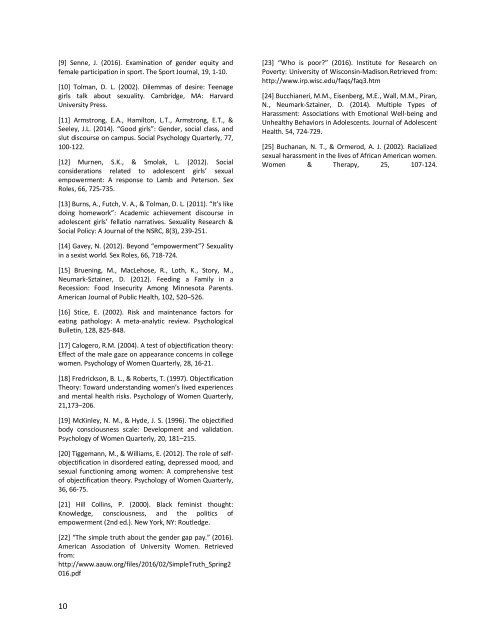NEDIC Conference Journal 2018
You also want an ePaper? Increase the reach of your titles
YUMPU automatically turns print PDFs into web optimized ePapers that Google loves.
[9] Senne, J. (2016). Examination of gender equity and<br />
female participation in sport. The Sport <strong>Journal</strong>, 19, 1-10.<br />
[10] Tolman, D. L. (2002). Dilemmas of desire: Teenage<br />
girls talk about sexuality. Cambridge, MA: Harvard<br />
University Press.<br />
[11] Armstrong, E.A., Hamilton, L.T., Armstrong, E.T., &<br />
Seeley, J.L. (2014). “Good girls”: Gender, social class, and<br />
slut discourse on campus. Social Psychology Quarterly, 77,<br />
100-122.<br />
[12] Murnen, S.K., & Smolak, L. (2012). Social<br />
considerations related to adolescent girls’ sexual<br />
empowerment: A response to Lamb and Peterson. Sex<br />
Roles, 66, 725-735.<br />
[23] “Who is poor?” (2016). Institute for Research on<br />
Poverty: University of Wisconsin-Madison.Retrieved from:<br />
http://www.irp.wisc.edu/faqs/faq3.htm<br />
[24] Bucchianeri, M.M., Eisenberg, M.E., Wall, M.M., Piran,<br />
N., Neumark-Sztainer, D. (2014). Multiple Types of<br />
Harassment: Associations with Emotional Well-being and<br />
Unhealthy Behaviors in Adolescents. <strong>Journal</strong> of Adolescent<br />
Health. 54, 724-729.<br />
[25] Buchanan, N. T., & Ormerod, A. J. (2002). Racialized<br />
sexual harassment in the lives of African American women.<br />
Women & Therapy, 25, 107-124.<br />
[13] Burns, A., Futch, V. A., & Tolman, D. L. (2011). “It’s like<br />
doing homework”: Academic achievement discourse in<br />
adolescent girls’ fellatio narratives. Sexuality Research &<br />
Social Policy: A <strong>Journal</strong> of the NSRC, 8(3), 239-251.<br />
[14] Gavey, N. (2012). Beyond “empowerment”? Sexuality<br />
in a sexist world. Sex Roles, 66, 718-724.<br />
[15] Bruening, M., MacLehose, R., Loth, K., Story, M.,<br />
Neumark-Sztainer, D. (2012). Feeding a Family in a<br />
Recession: Food Insecurity Among Minnesota Parents.<br />
American <strong>Journal</strong> of Public Health, 102, 520–526.<br />
[16] Stice, E. (2002). Risk and maintenance factors for<br />
eating pathology: A meta-analytic review. Psychological<br />
Bulletin, 128, 825-848.<br />
[17] Calogero, R.M. (2004). A test of objectification theory:<br />
Effect of the male gaze on appearance concerns in college<br />
women. Psychology of Women Quarterly, 28, 16-21.<br />
[18] Fredrickson, B. L., & Roberts, T. (1997). Objectification<br />
Theory: Toward understanding women’s lived experiences<br />
and mental health risks. Psychology of Women Quarterly,<br />
21,173–206.<br />
[19] McKinley, N. M., & Hyde, J. S. (1996). The objectified<br />
body consciousness scale: Development and validation.<br />
Psychology of Women Quarterly, 20, 181–215.<br />
[20] Tiggemann, M., & Williams, E. (2012). The role of selfobjectification<br />
in disordered eating, depressed mood, and<br />
sexual functioning among women: A comprehensive test<br />
of objectification theory. Psychology of Women Quarterly,<br />
36, 66-75.<br />
[21] Hill Collins, P. (2000). Black feminist thought:<br />
Knowledge, consciousness, and the politics of<br />
empowerment (2nd ed.). New York, NY: Routledge.<br />
[22] “The simple truth about the gender gap pay.” (2016).<br />
American Association of University Women. Retrieved<br />
from:<br />
http://www.aauw.org/files/2016/02/SimpleTruth_Spring2<br />
016.pdf<br />
10




